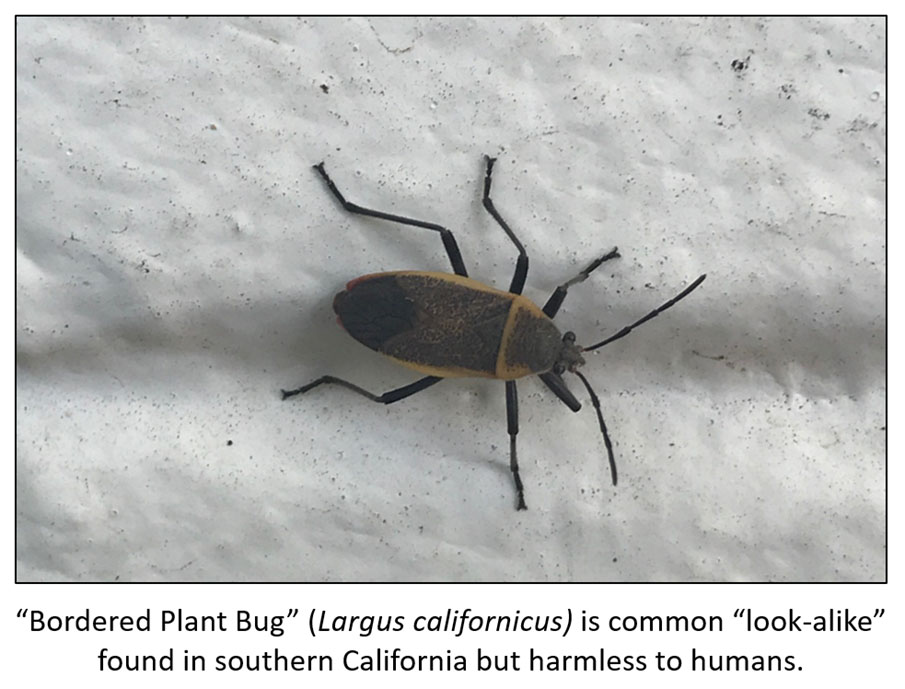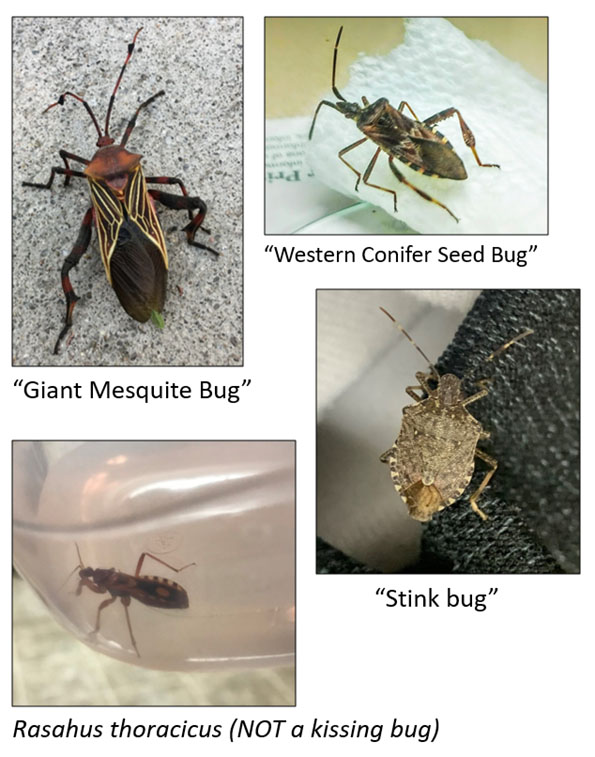Kissing Bugs
Kissing bugs (triatomines) are bloodsucking insects that are found primarily throughout the Americas. There are greater than 130 known triatomine species found naturally throughout the Western Hemisphere. They are best known as the vectors of Chagas disease, which is a parasitic infection caused by Trypanosoma cruzi. Very little is known about how these insects interact with humans and their dwellings here in the United States.
In North America, there are eleven known species of kissing bugs, which are found throughout the lower two-thirds of the continental United States and documented in at least 29 states (West Virginia included!). Their northern limit of distribution is likely determined by their intolerance to survive prolonged cold temperatures but reports from Utah and Colorado have shown these insects can be hardy.
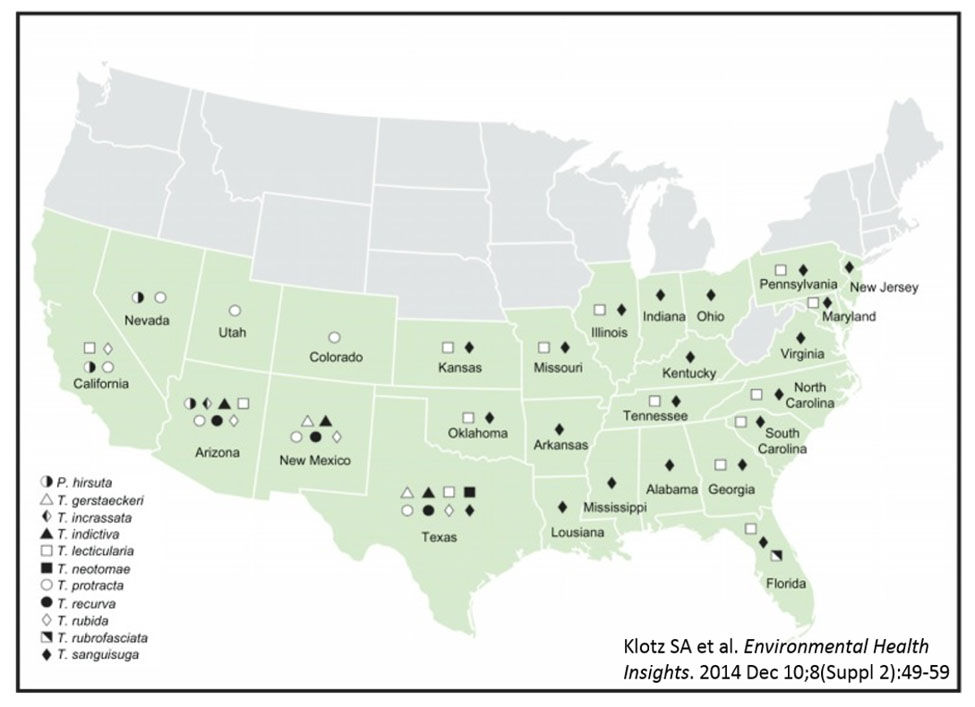
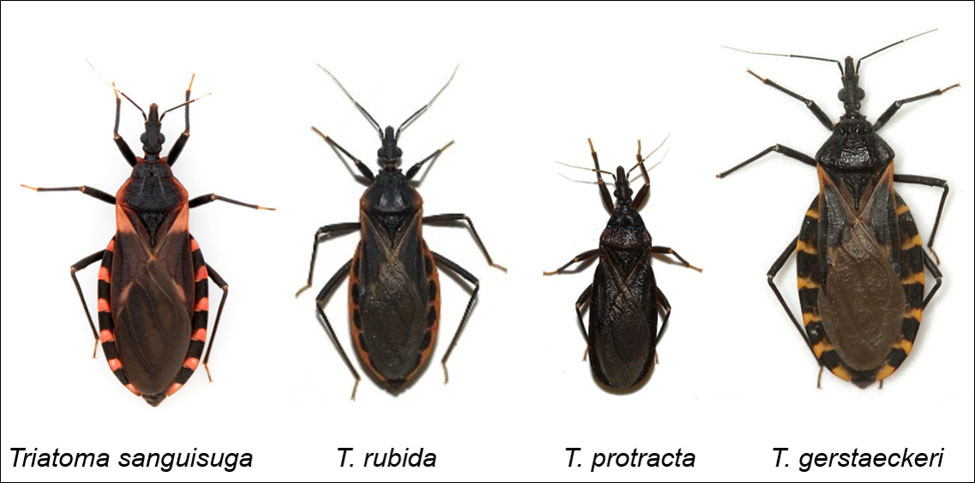
Triatoma sanguisuga is the most common kissing bug found in the United States and can be found from the eastern portions of Texas and stretching through parts of the Midwest all the way to the Atlantic east coast. This kissing bug is known for the colorful striped reddish and orange patterns on its thorax.
Triatoma rubida is naturally occurring in the desert southwest and throughout northern parts of Mexico. It is the predominant kissing bug found in the Sonoran Desert. It enjoys dry climates and rocky terrain. In the Arizona, New Mexico, and west Texas this kissing bug is commonly known to bite humans and recently been described to infest homes. Recent reports have indicated that it is likely associated with the transmission of Chagas disease.
Triatoma protracta is smaller than most kissing bugs but can pack a punch! Its natural range is found throughout the western parts of the United States and into northern Mexico. It is the predominant species found in California and well known for allergic reactions. Interestingly T. protracta has now been found as far north as Utah and Colorado, and appears to be able to withstand prolonged sub-freezing temperatures during the winter season.
Triatoma gerstaeckeri is the largest of the four and primarily found in central and southern reaches of Texas and portions of Mexico. In Texas this kissing bug is gaining a reputation for biting humans and being found near and around homes, ranches, dog kennels, and farms.
Learn how to get involved with kissing bug research through our citizen science program by clicking here.
Biology and Life Cycle of Kissing Bugs
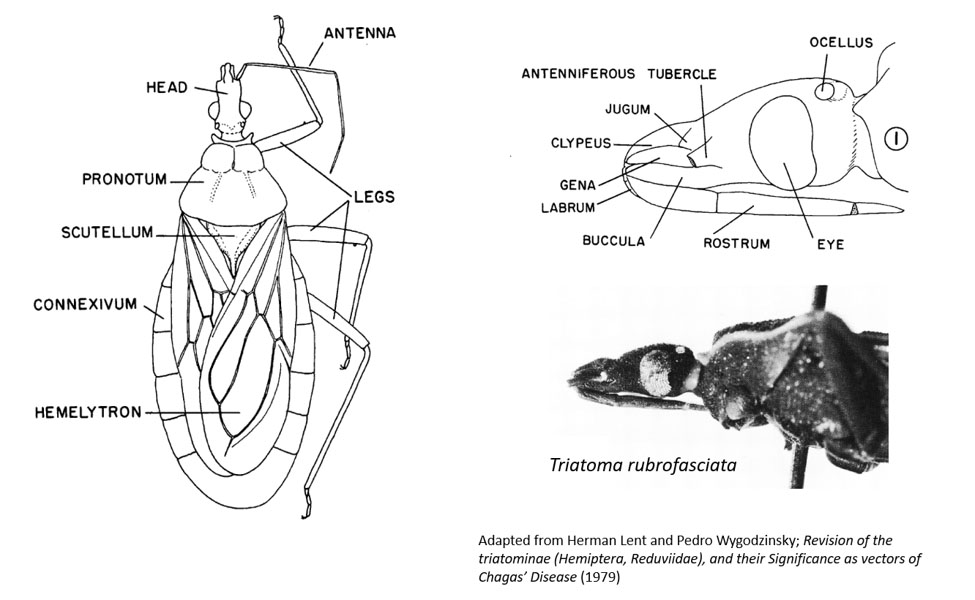
Kissing bugs are “true bugs” with six legs, often times long and skinny. They have a “cone nose” which contains a flexible rostrum which is known as a proboscis that can extend to allow the insect to take a blood meal. These bugs feed on the blood of vertebrates (hematophagous) but some species may sometimes feed on the hemolymph of other insects in times of starvation. Kissing bugs have a gradual development with five immature instars or “nymphs”. After hatching from the egg the first instar will typically feed within the first 2-3 days. Kissing bugs will attempt to engorge themselves when taking a blood meal and will digest the blood meal over multiple weeks, depending on the species. With each molt the kissing bugs will mature until the reaching the adult stage. Once reaching the adult stage these bus can be rather large, ranging in length from about 12 to 36mm. Females are typically larger than males.
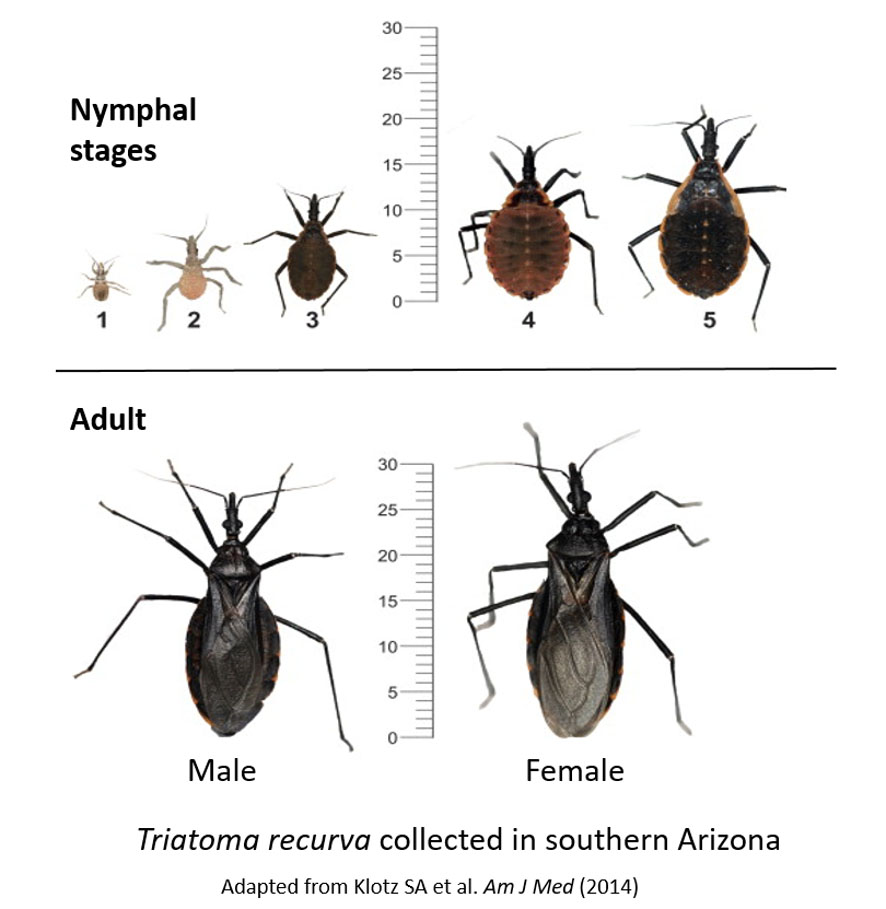
Kissing bugs tend to associate themselves with the den, nests, or burrows of animals such as rodents, small mammals and even birds. They seek refuge within the burrows, cavities, caves, and other locations with moderate temperatures, feeding throughout their lives in these locations. Females over their lifespan can lay up to several hundred eggs depending upon conditions. Active dispersal is achieved by flight in adults, usually around dusk and early evening. Immature kissing bugs cannot fly but crawl when stimulated to find a food source.
Habitat and Host Association
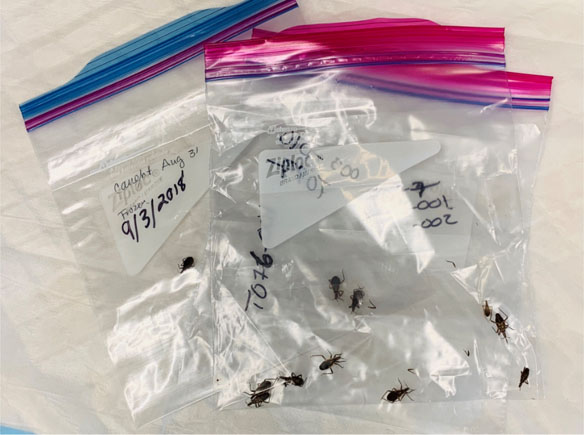
Kissing bugs inhabit a variety of ecological environments, including human domestic environments. They can be considered sylvatic, peridomestic, and/or domestic as it pertains to interactions with human beings. Some triatomines rarely encounter humans but others are well known invaders of our spaces! As mentioned above the four most common that are found in and around human dwellings are Triatoma sanguisuga, Triatoma rubida, Triatoma protracta, and Triatoma gerstaeckeri.
Each kissing bug will have its own niche within the surrounding ecology. Within these environments their feeding patterns can vary. For example in one study in Louisiana, kissing bugs most commonly fed on frogs! Even with the threat of being eaten they will find a blood meal. Kissing bugs will acquire a blood meal from a variety vertebrate hosts and tend to associate themselves with the den, nests, or burrows of animals such as rodents, small mammals and even birds. They seek refuge within the burrows, cavities, caves, and other locations with moderate temperatures, feeding throughout their lives in these locations.
However, they are also opportunistic and have demonstrated some interesting behaviors here in the United States, such as feeding on humans. When analyzing the contents of a blood meal source, kissing bugs have had human blood present in 30-40% of specimens. Other animals, including domestic pets (dogs, cats, birds), livestock (horses, goats, and sheep), and wild animals (horses, pigs, coyotes, raccoons, frogs, snakes) have been isolated on blood meal analysis. When and how some species of triatomines became specialists on humans is still a mystery that needs attention.
Dispersal of Kissing Bugs
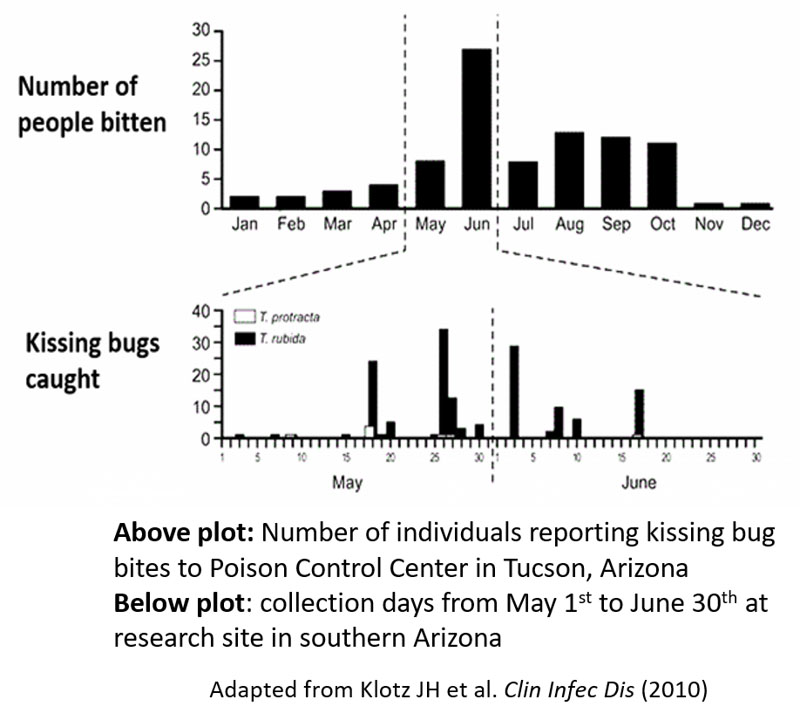 Kissing bugs are the most active during the dispersal period. This is when adult male and female kissing bugs emerge from a feeding location (animal dens…) with the intention to find a mate, reproduce, and subsequently lays their eggs for the next generation! Females will seek after a location where a food source can easily be found for the hatching nymphs. As you can imagine if that the inside of your home the nymphs will hatch and attempt to feed on the closest creature possible.
Kissing bugs are the most active during the dispersal period. This is when adult male and female kissing bugs emerge from a feeding location (animal dens…) with the intention to find a mate, reproduce, and subsequently lays their eggs for the next generation! Females will seek after a location where a food source can easily be found for the hatching nymphs. As you can imagine if that the inside of your home the nymphs will hatch and attempt to feed on the closest creature possible.Protecting Your Home from Kissing Bugs
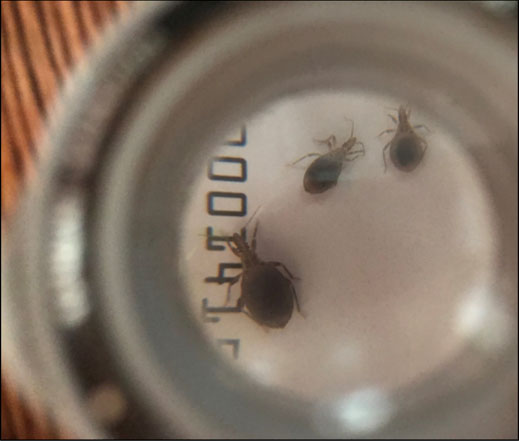
The best way to avoid kissing bugs that natural inhabit your surrounding environment is to prevent them from coming in and detour them from finding interest in your home!
- Inspect the structure in search of cracks and crevices that would allow a bug to enter the home and then seal them; For example: screens around windows, cracks between the windows and doors, door jamb itself, and any access to the attic (where other animals can nest).
- Use screens around windows and doors when they are open
- Change outside lighting to yellow bulbs (kissing bugs are attracted to certain lights more than others!)
- Keep surrounding yard free of clutter which will help prevent nesting and burrowing animals from nesting near the home
- Consult with pest control and consider residual pesticide administration
- When all else fails some will even sleep under a mosquito net!
Kissing Bug “look-alike”
